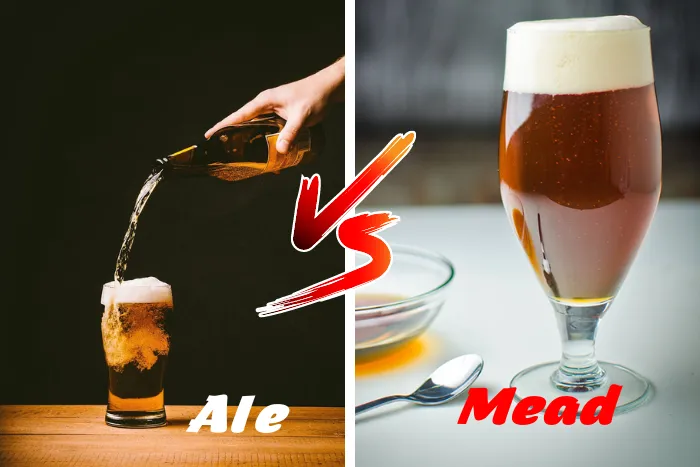For centuries, the debate of ale versus mead has been a popular topic regarding beer. Ale and mead are two of the oldest types of beer, each with its unique flavor profile and brewing process. Both ales and meads have different ingredients used in their production, fermentation processes that create different results, varying levels of bitterness (IBU), alcohol content, color profiles, and mouthfeel. In this blog post, we’ll explore the differences between these two ancient beverages and some popular varieties you should try.
Table of Contents:
- Origins of Ale and Mead
- Ingredients: Ale s Mead
- Fermentation and Brewing Processes for Ale and Mead
- Flavor Profile and Mouthfeel of Ale vs Mead
- FAQs in Relation to Ale vs Mead
- Conclusion
Origins of Ale and Mead

The history of ale and mead beer is rich with tradition. Malted grains were the base of ale, a beverage with ancient roots in Egypt and Sumeria, where early fermentation processes were employed. In medieval Europe, ale was a staple in the diets of both peasants and royalty alike.
Mead, an alcoholic drink crafted from honey, has been a favorite for millennia; its use can be traced back to 7000 BC in China, and it remains popular across Europe and parts of Africa. It has also had its share of popularity throughout European history and is widely consumed in Africa today.
Origin of Ale
Ale has been a part of the human diet since ancient Egypt when they developed a fermentation process for grain mashes using wild yeast strains found on fruits and vegetables. This technique spread across Europe over time, where it was known by various names such as ales (England), bière (France), birra (Italy), and cerveza (Spain).
Each region crafted its recipes with distinct flavor profiles, ranging from light lagers to dark stouts depending on the malt varieties like barley or wheat used in brewing, along with hops for bittering agents and spices for flavoring additions, cinnamon, or nutmeg.
Origin of Mead
Mead is believed to have had its genesis over 7000 years ago when humans discovered that honey could be fermented into an alcoholic beverage with a higher alcohol content than most wines due to the exclusive use of honey as its sugar source rather than fruit juices or grains used in beer-making processes.
This primitive version was called melomel, which eventually morphed into metheglin after herbs and spices were added during fermentation.
At the same time, braggot involved adding malt extract for more body akin to modern beers, though still possessing some sweetness not usually found in regular brews thanks to residual sugars left behind upon completion of fermentation.
Ale and mead have a long, storied history that has shaped the craft beer industry today. Moving on to ingredients used in ale and mead brewing, let’s explore what goes into making these popular beverages.
Ale Ingredients vs Mead Ingredients

Malt/Grains Used in Ale Brewing
Malted barley is the main ingredient used to make ale. Other grains, such as rye, oats, and wheat, can be used in ale brewing to provide distinct flavor profiles and varied contributions.
Each grain contributes distinct flavor and texture characteristics to the ale, such as wheat’s light sweetness, oats’ creamy body, or rye’s spiciness. For example, wheat provides a light sweetness, while oats add a creamy texture.
Rye gives off spicy notes often associated with certain styles of ales like saisons or IPAs. Malt offers hues and body to the beer, in addition to sugars that are converted into alcohol through fermentation.
Honey Used in Mead Brewing:
Honey is an essential ingredient when it comes to making mead since it’s what provides most of the sugar needed for fermentation. Different types of honey can contribute unique flavor characteristics, ranging from floral notes to fruity aromas or smoky tones.
The type of honey you use will depend on your desired flavor profile, but all kinds of honey should provide a nice balance between sweetness and dryness once appropriately fermented.
Yeast
Yeast plays a vital role in both ale and mead brewing since it is responsible for converting sugars into alcohol through the fermentation process. Different yeast strains can produce different results, from creating beers with higher esters to intensifying hop utilization during fermentation.
Yeast selection for beer brewing can vary, including ale yeasts, lager yeasts, wild ones (for sours), and Brettanomyces strains (for funky beers). Choosing which one to use depends mainly on the style you try to achieve, so research each strain before using them.
Fermentation and Brewing Processes for Ale and Mead
Brewing of Ale
Mashing converts grain starches into fermentable sugars. Grain starches must be soaked in hot water between 149-158°F (65-70°C) to become fermentable sugars. This step produces different sugars depending on temperature and time. Grain enzymes break down complex carbohydrates like maltose and dextrin during mashing. Yeast ferments simple sugars into alcohol.
Depending on your beer, hops or other flavorings are boiled into the mash. Boiling sanitizes wort (unfermented beer) and extracts hop bitterness and aromas and flavors from herbs and spices added at this stage. It evaporates diacetyl and dimethyl sulfide from mashing (DMS).
Brewing of Mead
Mashing ferments grain starches. Soak grain starches in hot water between 149-158°F (65-70°C) to ferment grain starches. The sugars in this step are affected by temperature and time. During mashing, enzymes from the grain break down maltose and dextrin. Simple sugars are turned into alcohol by yeast.
Hops or other flavorings are boiled into the mash. Boiling sanitizes unfermented beer and extracts hop bitterness and herbs and spices. Mashing diacetyl and dimethyl sulfide evaporate (DMS).
Unlike ale brewing, Mead fermentation uses honey instead of malted barley or wheat for sugar. Honey already has yeasts in it, so no extra yeast is needed before fermentation, but adding a strain that works well with mead can make the consistency better.
Depending on how long it ferments, honey’s natural sugars turn into ethanol (alcohol), carbon dioxide gas, heat energy, and compounds that make honey taste better, like esters and phenols.
The fermentation and brewing processes for ale and mead can be complex, but understanding them is essential to creating the perfect beer. Next, we’ll delve into ales and meads’ various tastes and hues, their ABV levels, IBU ratings, and health consequences.
Taste of Ale Beers
Both mead and ale are fermented drinks, but they are not the same. The malt and hops used in the brewing process produce these aromas. The type of hop used will determine how intense or subtle these aromas are. For example, a beer brewed with Cascade hops may have more citrusy notes, while a beer brewed with Centennial hops might have more herbal aromas. In addition, yeast strains can bring about esters emitting fruity aromas such as banana or bubblegum, thus adding to the beer’s flavor.
Taste of Mead Beers
Mead beers typically possess a sweetness imparted by honey used in fermentation, although additional ingredients can contribute various flavors. Mead beers can taste sour, tart, earthy, or herbal depending on the herbs and fruits used during fermentation.
Flavor of Ale vs Mead Flavor
Many people enjoy both types of beer because of their mouthfeel. Grain proteins give ales body and complexity, while honey gives meads sweetness. Both types can be light-bodied and low-carbonated or creamy and tongue-coating.
Colour Range of Ale vs Mead Colour
The color range for ales and meads varies greatly depending on the ingredients used during production and any additional steps taken post-fermentation, such as aging in oak barrels or adding fruit juices for extra flavor complexity.
Generally speaking, though, most ales fall into hues between golden yellow to dark brown. Depending on how much sugar remains after fermentation, meads range from pale gold to deep amber.
FAQs in Relation to Ale vs Mead
What is difference between mead and ale?
Both mead and ale are fermented drinks, but they are not the same. Most of the time, mead tastes sweet, like honey, while ales usually taste bitter. Ale ferments in weeks, but mead takes months or years to reach its peak flavor.
Due to honey’s high sugar content, mead has more alcohol than ales. Most of the time, mead tastes sweet, like honey, while ales usually taste more bitter.
Why is mead not popular anymore?
Mead, a fermented honey-water beverage, has been around for centuries but is less popular today. Due to its higher production cost and consumer tastes, mead’s popularity has declined.
Additionally, fewer places are selling mead than before due to low demand. These factors and modern society’s preference for lighter drinks like beer and wine over stronger ones like mead have caused this ancient drink to lose popularity.
What is healthier mead or beer?
Mead and beer are alcoholic beverages, but Mead has the edge regarding health benefits. Honey and water are used to make mead, while barley or wheat are used to make beer.
With its nutrient-rich honey content, Mead may offer more excellent health benefits than beer. Mead has fewer calories and alcohol than most beers (8-15% ABV), so you can drink more without consuming too much. Ultimately, if consumed in moderation, either drink could be considered healthy depending on individual dietary needs.
Is mead stronger than beer?
Mead is an alcoholic drink made by letting honey ferment. Depending on the recipe, the strength of the drink can vary. Mead is typically stronger than beer because of the greater sugar content in honey compared to grains employed for brewing. Nevertheless, certain beers can have a higher ABV than some meads if made with added hops or malt extract. Honey ferments into mead, which is an alcoholic drink. The drink’s strength can change depending on the recipe.
Conclusion
In conclusion, ale and mead beers are two distinct types of beer with different origins, ingredients, fermentation processes, flavor profiles, and mouthfeel. Ale is typically a darker-colored beer with more bitterness than mead due to its higher alcohol content. On the other hand, mead is lighter in color with less bitterness and usually has lower alcohol content. Ultimately it’s up to you as a consumer which type of beer you prefer when comparing ale vs. mead; both offer unique flavors for your palate.
Discover the best ales and meads with our comprehensive beer reviews. Access your favorite beers, brewing equipment, and subscription services right here!
Also Visit: How Much Sugar Is in Non-Alcoholic Beer?
